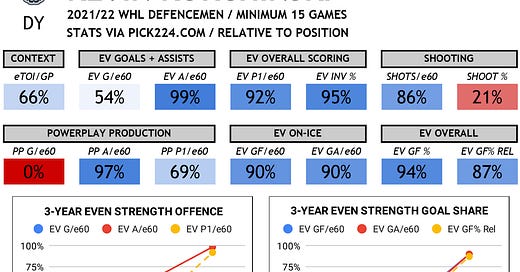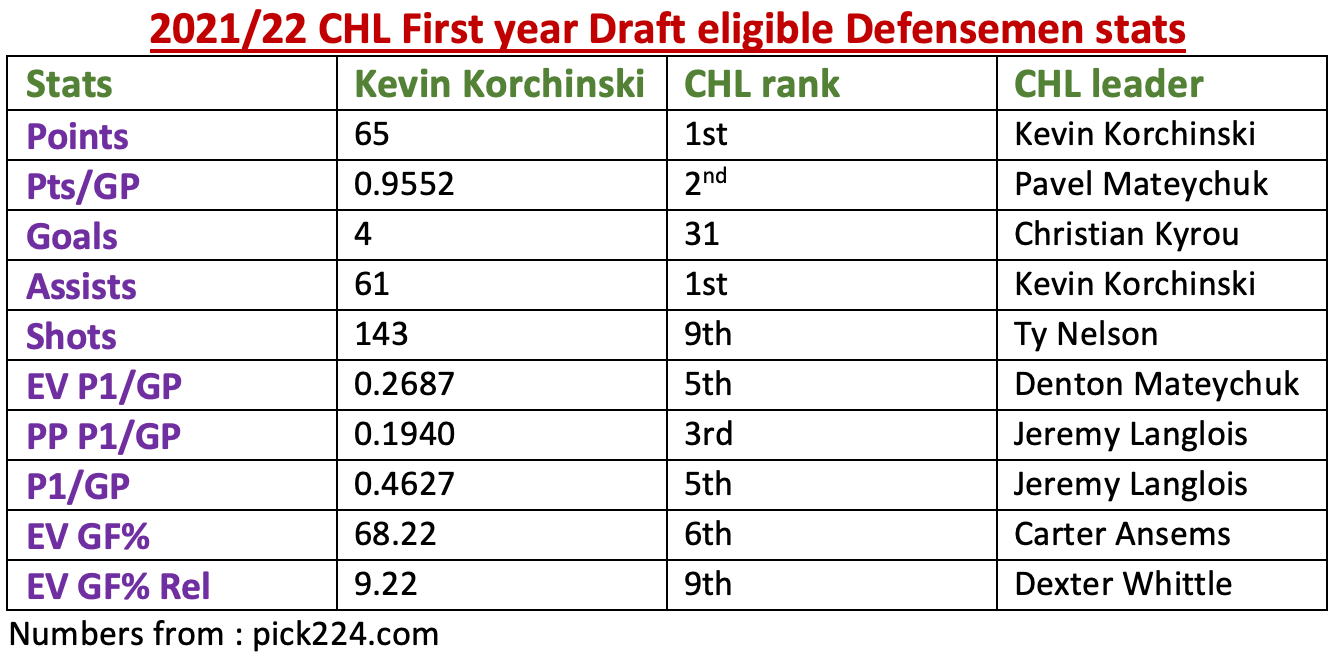2022 NHL Draft Profile: Kevin Korchinski
With the NHL Draft coming in about a month, we'll take a look at some eligible defensemen in the next few weeks.
Today's post is about one of the most dynamic and offensively gifted defensemen of this draft, Seattle Thunderbirds LD Kevin Korchinski (#14).
THE NUMBERS
Korchinski had a dominant season with 65 points in 67 games. He maintains a similar pace in the playoffs with 18 points in 22 games (still counting), playing in the WHL final against Edmonton. According to Byron Bader's tools Hockey Prospecting, Korchinski ranks fourth in terms of DY Star probability & DY NHL’er probability amongst 2022 NHL draft defensemen, behind Nemec, Hutson, and Mateychuk. His statistical profile compares well with NHL'er Thomas Chabot & Shea Theodore, two defensemen who can be decent comparable in therm of playing style for Korchinski (NOT a player comparison, just some similarities in playing style):
As you can see in Kyle Cushman's players' card, Korchinski was dominant everywhere besides shooting/scoring. The playmaking abilities are elite:
Here's a simple chart to see where Korchinski's numbers rank among CHL 1st year draft-eligible defensemen this season. The 65 assists are extremely impressive:
All numbers from pick224.com
VIDEO ROOM BY ZONE
OFFENSIVELY
DEFENSIVE ZONE PUCK RETRIEVALS/BREAKOUT
Korchinski was dominant on breakout retrievals in the games I watched and tracked. In my opinion, he excels on ''long retrieval'' (for example a puck dumped in his corner from the NZ).
His mobility allows him to pivot and get back quickly on pucks, plus he scans and shoulder checks multiple times while keeping his feet in motion. If there's a quick play to make, he processes the game fast and has the under handle skill to execute it.
If no quick options are available, Korchinski has the poise under pressure and skating abilities to be patient to find the best play available.
With his skills, skating (punch-turn), poise (patience under pressure), and deception (route and feet, hip pocket), Korchinski often beats F1 and attracts F2 before making his play, which creates a positive numerical advantage for his teammates after his 1st pass.
When there's no space to beat F1 with his skating/deception, Korchinski is good at using his size and reach to absorb the hit/create an offensive contact for a 2nd quick to his D partner/center support.
The area where he can improve on breakouts is when he retrieves a puck coming from a play already in the defensive zone (for example a shot from the point that is redirected in the corner). It's harder to use skating or deception to evade F1 in these situations because you are less in movement and there's less space than on a long retrieval. Making quicker reads and more efficient plays in these situations can be an area of improvement for Korchinski.
NEUTRAL ZONE TRANSITION
Neutral zone transition is another strength of Korchinski's game. Firstly, he's great at passing and executing fast in transition. As you can see in the video, multiple times he identified situations to play fast: Bypassing F1 and F2 when they were attracted on NZFC, beating an NZFC that isn't set with good passing, and playing fast when the other team change lines). His team got many scoring chances on the rush in these situations. In therm of individual habits, he makes blended catches directly in his hip pocket with his eyes up and I also like the accuracy of his passing and how he uses indirect passes. All important details to execute in transition.
When carrying the puck, he's got good skill and agility, and I like how he can beat F1 by playing off-the-heels (for a great on this topic). Without the puck in transition, he's activating in the rush. I love his ability to fill lanes in any role (F2, F3, F4). A detail he can improve when joining the rush is to be a bit more patient in open space (at 2:00 in the video he scores because of his skills, but he receives the pass too close to the defender. At the NHL level, the defenseman has a stick on this play).
The aspect where he can improve with the puck in transition is when he gets a puck against an already perfectly set NZFC. As a general concept in hockey, that's a situation where it's better to slow things down in the neutral zone and build speed. He can force plays/carry through set NZFC, which can create costly turnovers.
OFFENSIVE ZONE PLAY
Korchinski is money in the offensive zone, the best part of his game. The video tells us what we need to see.
Individually, he combines skills (blended catch), agility (punch turn, lateral punch cut), and deception (hip pocket, fake shot) to create out of nothing and to look for the best possible play. I'd consider his shot average, but I mostly like his shot selection (when traffic/players are going to the net).
The vision is incredible. Accurate passing, lead passes, royal road plays.
When he's not in possession, he's always in movement and looking to activate off-the-puck to get in a better location and create chaos for the defensive team. His off-the-puck activations will fit well with many NHL teams' OZP.
DEFENSIVELY
RUSH DEFENSE
Overall, there's a lot to like about Korchinski's rush defense with his ability to cover the ice with his length and mobility. There are many details that can be improved as well.
Rush D as D1: I like how Korchinski sets his gap in the offensive zone. He's active and takes off from the blueline to gap up to the highest opposing forward. When he receives the rush as D1, he is decently adept at gaining the inside dot to keep the carrying forward on the wall.
Rush D as D2: In the offensive zone, he does a great job of ''sitting'' on the opposing winger to eliminate the passing option when there's a change of side play behind the net. In the neutral zone, I like how he uses his lateral mobility and defends skating forward when there's a change of side play (across pass). When he's defending as D2 without the puck, he keeps a tight gap to seal his check.
While there's a lot of positive, Korchinski needs to improve many details when defending the rush. First, he needs to improve his stickwork. There's too much sweeping motion when trying to break the play, which gives space and an open triangle to make plays for the carrier. His stick is often in the air (off the ice) when he pivots, giving free ice to the carrier.
Sometimes, his gap can be a bit loose, and he needs to read when to be aggressive versus when to be more passive (see if SEA has an F3/tracker involved, counting numerical in front of him, etc.).
DEFENSIVE ZONE COVERAGE
That's the aspect of Korchinski's game that needs the most refinement.
He can do some positive actions, like in the video. Scanning to find his check, killing the play aggressively with his stick, boxing out/taking the stick of his check when the puck is high at the blueline.
Where he needs to improve is that he can get caught puck watching and running around too much. Winning his races back to the home plate and identifying situations in a more structured way will help him in that regard.
POWER PLAY
Overall, Korchinski is a top PP QB (for more on PP QB details). On the breakout, he uses deception to send false information to find the best play. In the zone, he's talented, sees the ice well and although he's not a shooter, he good at keeping the PK honest with solid shot selections.
Some details need to be refined, like when to take off the blueline versus when to stay on the blueline when walking laterally, gaining the middle line of the zone to create more space for the half-wall player, and passing in the opposite direction of his feet.
Overall, that's a strong part of his game that translates well at the next level.
PROJECTION
I'm a believer in Korchinski's game. For me, he's already a dominant defenseman that still has a lot of room to improve and get better. He's tall, athletic, creative, and talented. According to his coach in Seattle, Korchinski grew six inches from his WHL Draft year to this season. He's still got a lot of room to grow in terms of improvement in his strength and coordination. The aspects he needs to work on (defensive zone coverage, details in rush defense, limiting turnovers in certain situations, and getting more acceleration out of changes of direction) are things that can be worked on and that NHL organizations (coaches plus development staffs) have success in improving. His rankings are a bit all over the place from top 10 to early 20s, but with the high-end upside of his game (top pairing potential if the defense can take a significant step) and kind of a solid bet to have an impact as a bottom 4 offensive defenseman if the defensive doesn't take the step it needs, I can't how Korchinski isn't a top 15 on July 7th in Montréal.
Clips taken from In Stat






